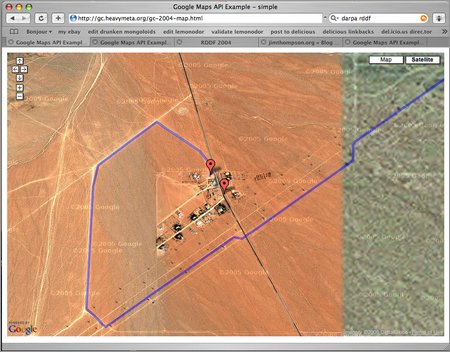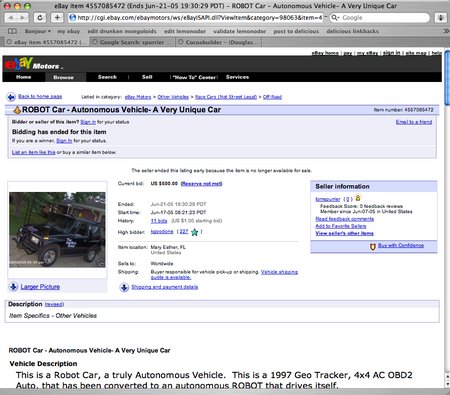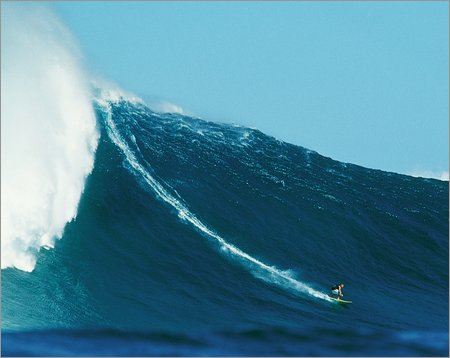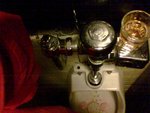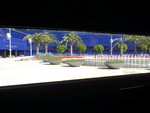June 29, 2005
Google Maps API
The new Google Maps API is really easy to use; I was able to create a map of the 2004 DARPA Grand Challenge route in about half an hour. After another hour or so I had some primitive clipping and adaptive level-of-detail working so that it didn't build the whole path of 2700 or so segments if you were just zoomed in on the Slash X cafe.
It wouldn't be much harder to add things like corridor widths or animations of the route. Or markers showing the maximum distance that each vehicle achieved (if that information were available).
Update: I couldn't help myself, I added markers at the final position of every vehicle that got out of the starting gate. The positions are roughly estimated from the Final DARPA report and some great circle distance calculations. If you click on a marker, you'll see the summary from the report regarding that particular vehicle.
Fluxus
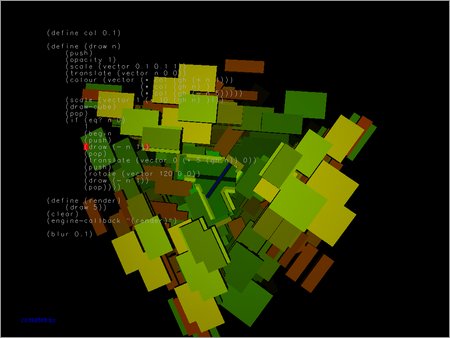
Fluxus is a Scheme-based system for doing live 3D graphics based on audio input, with a built-in physics engine.
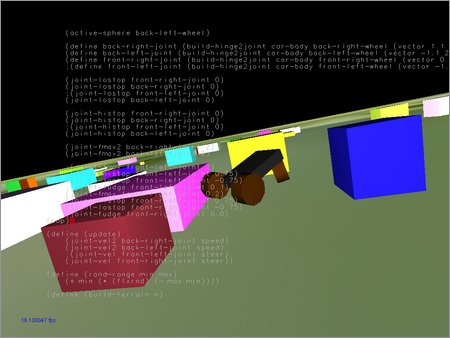
The source code in these screenshots is not static; that's the code editor. You can modify the code while it's running, which is kind of neat.
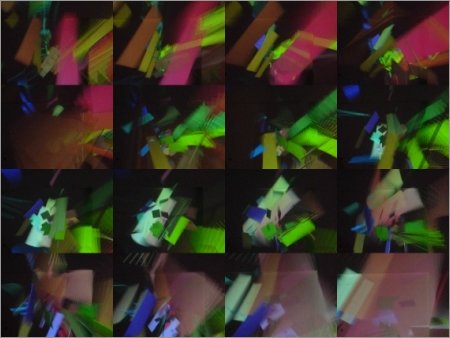
Dave Griffiths, author of Fluxus, has a great bunch of audio and graphics hacks listed on his homepage.
June 28, 2005
Rodney Brooks: Innovation at the Interface
Geoff has a nice description of this Rodney Brooks talk from last year, but there were a few things I wanted to emphasize.
Brooks seems to think that the robotics market is about to take off. He says that “Computers in 1978 are where mobile robots were in 2001.” The military use of robots is surging, there are amateur robotics hacking clubs, and we've recently seen the first few attempts to bring robots to the mass market. Brooks talks a little about one of those attempts by a company that is close to my heart:
More recently we start to see companies out there like Evolution Robotics, out in California, as a product that you can go buy, and it's a mobile robot platform you can put your laptop into and you can program it with a GUI interface to do all sorts of things around your house.
The example they're most proud of is having a robot go to the fridge, open it, pick out a beer, and bring it to you.
Brooks then talks a little about what's going to drive growth in robotics, saying that we “shouldn't underestimate importance of infusion of government money in changing the landscape in robotics.” And the primary government driver for the next couple decades has to be the huge Future Combat Systems (FCS) initiative, which focuses on unmanned systems. FCS has a total lifecycle budget of $150 billion, with $15 billion marked for R&D.
June 27, 2005
ILC Breakdown
Will's take on ILC 2005 includes a breakdown of the types of people attending that seems pretty accurate, including these two:
The Ex-Lispers. These are people who are use to use Lisp, maybe even love Lisp, but don’t use it anymore. For some reason, several of these folks were plenary speakers.
The Yeomen. These were people who use Lisp to write large-scale projects used by thousands or even millions of people, or that have a significant, or even huge, impact on the world. Unfortunately, there wasn’t anyone like this.
Also, I wasn't sure if the lone female attendee Will mentioned was in fact an attendee, so I guess I feel better about that. I think I remember at least two or three women in New York in 2003, which means we're losing women at the rate of 0.75/year. Plan accordingly.
June 25, 2005
Nine for Lisp
Nine(!) of LispNYC's proposed Summer of Code projects are being funded by Google [via Dirk Gerrits]:
- Lisp Sockets - “The proposal is to create single socket library with a standard interface for all Lisp implementations in all environments. This will be accomplished by using a portable OS FFI (Foreign Function Interface) to gain access to native C socket libraries.”
- FetterFfi - “A program will be created to automatically generate foreign function interface (FFI) bindings directly from C++ header files. The program will implement this functionality using GCC-XML to parse C++ header files, giving it the ability to support a wide range of C++ features.”
- AxiomUI - “The goal of this project is to provide a platform independent graphical user interface to the computer algebra system Axiom.”
- GoDb - “This project will build a new interface to the GO Database (www.geneontology.org, www.godatabase.org/dev) that caches the queries one makes in order to improve speed.”
- Hello-C - “Hello-C is a recent fork of UFFI, or Universal Foreign Function Interface. Hello-C adds support for callbacks from C, and is meant to allow UFFI to move forward, since UFFI's originator needs it to remain stable for his own work.”
- PltStepper - “Presently, the PLT scheme stepper only works with the beginner and intermediate levels of the language. Extend it to be a general part of all of the language levels.”
- PltDb - “There are a number of projects that have created database drivers for PLT Scheme, but there is not yet a unified API. The project is to create a unified API and then adapt the existing drivers or create new ones as necessary to use this unified API.”
- Slime Stepper - “Although Slime is getting better everyday, it still lacks some important debugging tools. The stepper is one of those tools.”
- ErLisp - “The Erlisp project aims at extending the most popular Common Lisp implementations in order to make the concurrent programming features of Erlang available to them.”
June 24, 2005
ILC 2005 Photos
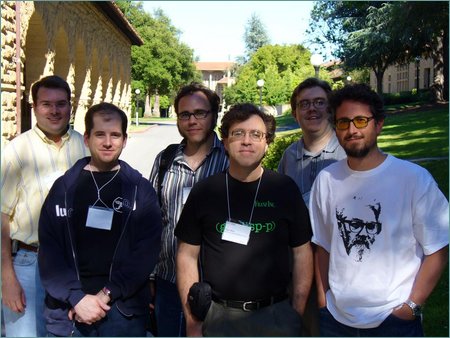
The International Lisp Conference: still the premier conference for white guys in glasses.
Brian Mastenbrook has about 60 photos from ILC 2005, and Kevin Layer of Franz has about 30 from day two and 30 from day four.
June 22, 2005
Interrogation
I forgot to mention I had a little run-in with the law this past weekend. It was just a misunderstanding, and I didn't do anything wrong, but that didn't stop them from roughing me up a little.
Innovation Happens Elsewhere

John Martin, Fall of Babylon from Illustrations from the Bible, 1835. I'm a sucker for this hyperdramatic 19th century stuff.
Ron Goldman and Richard Gabriel [Dave: Peter is someone else, but I wouldn't mind if he showed up to ILC] have a new book out: Innovation Happens Elsewhere: Open Source as Business Strategy [via Ted Leung.]
The book will eventually be available online.
Autonomous Geo Tracker Auctioned
What do you do if your Grand Challenge team didn't make it to the qualifying round of the 2005 contest? Get a head start on 2006? Or try to recoup your investment via eBay? [pdf]
Spurrier's Hurriers [google cache of the team website] seems to have chosen the latter.
The vehicle was designed to compete in the GrandChallenge.org off road 200 mile race but was not completed in time to pass a site visit. The vehicle is now complete and will be demonstrated at the selling site if desired.
Note that “The seller ended this listing early because the item is no longer available for sale”.
June 21, 2005
ILC 2005 x 1/2
![]()
I drove the Chrysler up to Palo Alto tonight; I figured I could handle two days of ILC 2005. All four windows rolled down, as neck suggested.
The car's been making a little bit of a new noise the past week or two, since I got the new alternator and belt. I hoped that the noise wasn't foreshadowing a terrible breakdown somewhere in the central valley, which I like to think of as the most midwestern part of California, being both very flat and a region of the state that is usually crossed at maximum speed by Los Angeles people shuttling to the Bay area, and vice versa. A breakdown at night would mean being out on the highway when the fog rolls in. Daytime in the central valley isn't as brutal now as it will be once summer really gets going, but it still wouldn't be fun to be stuck on the side of the 5 with the sun beating down on me.
At least I have a brand new radiator, so the classic scenario of overheating on the Grapevine isn't too likely.
I'm a little surprised not to have seen anything on Planet Lisp from people at ILC. (Oh, looks like Franz just posted some photos. Hm, they have some older pictures up, too. Whoa--check me out in 1998!) Four days is a little much for me; I wonder what tradeoffs would be involved in doing a two day conference.
June 16, 2005
Shaky
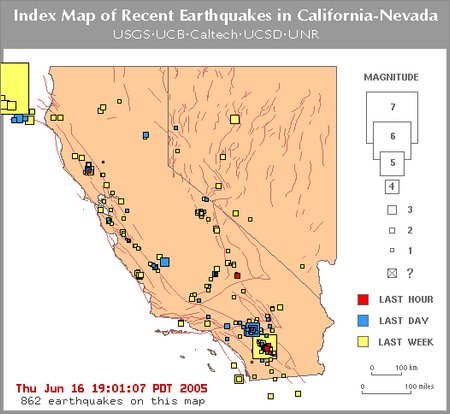
Today's 4.9 is the strongest earthquake I've felt since moving out here three years ago (the 4.8 quake that occurred a few months after I arrived, despite being much closer, was nothing compared to this one--which makes me think that when Mike Davis knows what he's talking about when he says Los Angeles is located above a bowl-shaped layer of bedrock that reflects seismic waves in unpredictable ways). Just as the rattling and shaking reached the point where I realized it had to be an earthquake it was over. The cats noticed something odd was happening just a second after I did (obviously evidence that animals have an odd obliviousness and mysterious deficiency of intuition).
I'm sure the geologists are smirking at our collective naivete, but I'm one of those people who finds himself just a little concerned about all this recent geological activity. And I'm not even worried about earthquakes; for a few minutes the other night there was a real possibility of a tsunami hitting California. And what I'm really afraid to consider is that what we've seen in the last year--the California earthquakes of the past week, the Indian Ocean earthquake of December, increased geothermal activity forcing rangers to close trails at Yellowstone National Park--is just the supervolcano reactivation sequence.
June 15, 2005
June 13, 2005
What Now
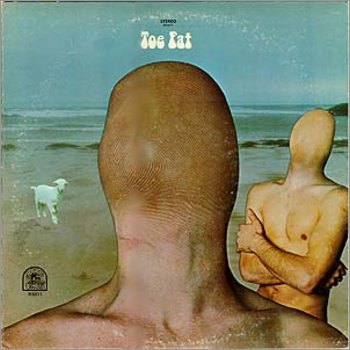
Last Thursday was my final day as a full-time employee of Evolution Robotics. I've been thinking about this for a long time; I knew I wanted to try consulting, but even though I've worked at small startups for the past 10 years it still felt like a big leap to go independent.
I have now made that leap.
I'll be helping Evolution for a while, but I can't wait to rustle up some interesting work after that. I tell people I'm now a freelance roboticist, but the truth is I wouldn't mind working in some different areas, too. This should be fun.
June 08, 2005
CafeSpot
CafeSpot is a guide to independent coffee shops and restuarants that relies on user-contributed content. It is social software, it's geocoded and it's tagged, and otherwise has the look of a typical Web 2.0 app. This time it's written in Lisp
It has warts, but it might even be a nice, useful app soon.
June 07, 2005
Grand Challenge Competition Narrows
DARPA made the big cut yesterday, choosing only 40 of 118 teams to become Grand Challenge semi-finalists (press release, MSNBC article). Teams were selected based on their performance during “site visit” test runs in front of DARPA officials.
In September's qualification runs at Fontana Speedway, 20 teams will be selected as finalists and will then compete for the now $2 million prize on October 8.
I'm glad to see that the Blue Team and the Palos Verdes High School Road Warriors made it this far. CMU, trying to increase their odds, has two vehicles in the semi-finals.
June 06, 2005
Setf Panoply
Brian Mastenbrook and Paul Dietz came up with 18 ways in Common Lisp that one can either directly define or cause to be defined functions of the form (setf foo). This may be an exhaustive list, but I wouldn't be surprised if it's not.
First Summer Weekend
Heidi visited. There was a lot of art, picnicking next to dead people and tremendous snacking.
June 03, 2005
Lispworks 4.4.5 Personal Edition
Xanalys announced the release of the personal edition of LispWorks 4.4.5 (the non-pesonal edition was released on April 15).
Version 4.4.5's release notes mention lost of fixes and new features. In particular, OS X got a lot of attention, with a new Objective C interface that lets one implement Obj C classes in Lisp and use NIB files, and support for OS X 10.4 (Tiger).
One of the items listed under Known Problems is indeed troubling (though a workaround is identified):
The license serial number and key have to be entered again on the command line if the machine's hostname changes. Some Macintosh machines change hostname when disconnected in the Internet which is the most frequent cause of this problem.
This just isn't 1990; These days unix machines change hostnames and IP addresses all the time.*
* Though the primary means by which this happens in contemporary times might be by switching between wireless access points, and linux sure doesn't do much to make that easier. Where's the bounty for this most common, mundane and helpful of tasks?
June 02, 2005
Ghetto Presentations
Alan Ruttenberg announces his presentation-like hack on the slime-devel mailing list:
As an example, I've hooked that into the printing of unreadable objects in openmcl and cmucl. So all unreadable objects are now mouse sensitive and can be copied and used in expressions in the repl.
I remember when Alan did the same thing for MCL's REPL, it was probably 10 years ago.
Lisp NYC's Summer of Code
The Lisp NYC user group got themselves listed as a sponsor for Google's Summer of Code.
They have a list in-progress of ways you can spend your summer coding Lisp and earning $4500, in case, as wmf says, you were too lazy to start a company:
- Create a Common Lisp interface to Posix and support it on several Lisp implementations.
- Port CMUCL's metaobject protocol implementation to SBCL.
- Create an implementation of SSL in Common Lisp.
- Create a Common Lisp library that implements the Jabber chat protocol.
- Work on merging GCL, the GNU Common Lisp implementation, into GCC, the GNU Compiler Collection.
- Improve the compiler optimizations in SBCL.
- Improve Closure, a web browser written in Common Lisp. Perhaps integrate JavaScript functionality. The first JavaScript implementation was written in Lisp.
- Translate a popular Python or Perl library into Common Lisp.
- Robocup: team strategy modifications based on input, either GA or macro based mods in real-time.
- Author a non-trivial CLRFI, possibly cross-platform multi-threading.
- Author a comphrensive HowTo: HowTo [not get] sued given the recent "advancements" in IP and copyright law
- Additions to electronic music generation software, see MuSIG.
- What percentage of functions of ANSI Common Lisp are used by production applications? Can it be broken down into the 80/20 rule?
- Upgrade a Common Lisp system such that it's streams compete with those of Java in features and performance.
- Add an interesting cross-platform feature to Slime. MOP support? Make it as easy to use as Visual Studio?
- Make Wikis impervious to today's automated spamming technology while still maintaining openness. Captchas vs community? Document how it may become upsurped.
- Cross Emacs'es Eshell with Tramp: make eshell work on remote hosts.
- Implement a Common Lisp MUD that is argeeable to agents but with robust security (not a trivial task), must also be able to use a Jabber for a client front-end.
- Create a portable, cross-platform user-runnable installer, possibly by combining ASDF and defsystem.
- Design a higher-math curriculum that would interest [non math oriented] computer-science students.
- Implement a self-hosted indexing and display system for the Lisp Resource Kit's many different forms and levels of content, including video.
Brooklyn, We Back
VIENNA — A tense standoff between Austrian counter-terrorist forces and the FreeBSD-based server running the extremist website “lemonodor.com” ended peacefully today when a rookie police translator finally recognized the phrase “Beyoncé ur d bomb!!1!”* as nothing more than an obsolete colloquialism of “hip hop” music culture.
The web site, which went down while fending off waves of bomb-defusing robots, was reconnected this morning.
* Don't think that can't happen.
